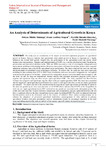| dc.description.abstract | The study was an examination of the impact of structural adjustment programs on agricultural growth in Kenya. Statistics indicate that agricultural value added growth in Kenya is important as it highly influences the overall GDP growth. Despite this, the performance of the agricultural sector has shown mixed fortunes since independence. Adoption and implementation of SAPS (e.g., currency devaluation, trade liberalization, privatization, and removal of subsidies) in the 1980s and 1990s was seen as a way of reversing the widespread social and economic problems of developing nations. However, there exists a difference in opinions on how these structural adjustment programs have affected the agricultural sector performance. The study examined the short run and long run determinants of agricultural sector performance in Kenya. To achieve this, the study use time series regressionmodeling for data spanning from 1975 to 2010. Tests of normality, unit roots test and co integrationtest was applied to determine the properties of the data. Upon proof of co integration, an error correction model was estimated to link the short run and the long run relationships. Results indicate that structural adjustment program(SAPs) had a negative and significant long run effect on per capita agriculture GDP. The study concluded that Post Election Violence has a negative and significant long run effect on the per capital agriculture GDP. The study also concluded that the lagged per capital agricultural performance has a positive and significant effect on the per capita agricultural performance. The results also led to the conclusion that the long run per capita agricultural growth may be linked to the short run growth by an error correction term of -0.242583 which indicates that 0.242% of the disequilibria in short run per capita agricultural sector GDP achieved in one period are corrected in the subsequent period. The results also concludes that weather indicators (temperature and precipitation), and per capita infrastructure did not have a significant effect on the short run and long run per capita Agricultural GDP. The study recommends that some harmful policies need to be eliminated such as the removal of subsidies. Other policy recommendation are to enhance the adaptation of privatized agricultural institutions; encouragement of value addition in primary agricultural products; non price mechanisms such as Infrastructure should be encouraged especially in the rural areas; and enhancement of the political stability of the country especially during electioneering years. | en_US |

